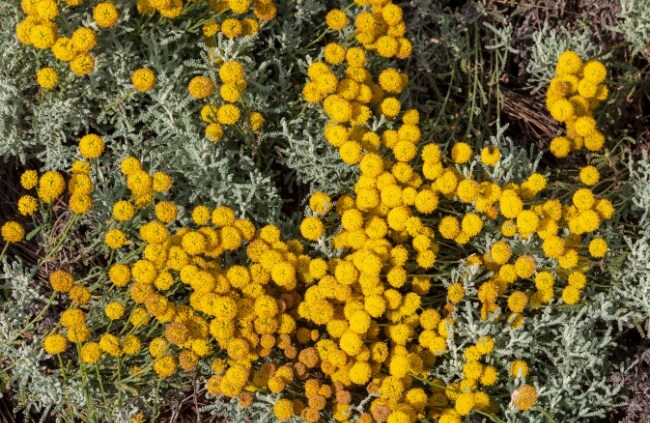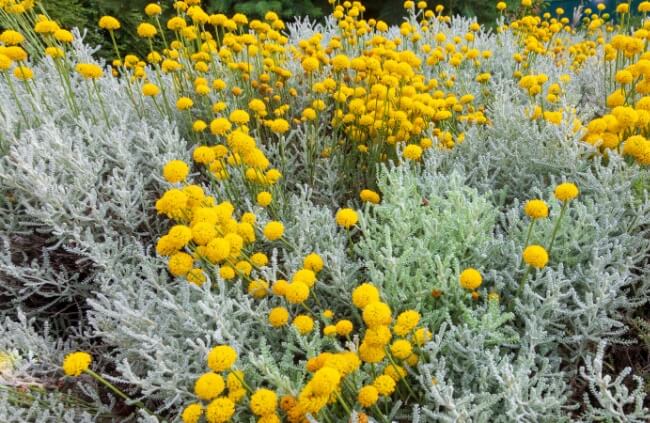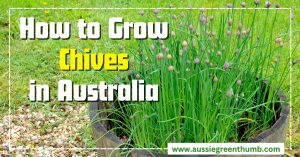Santolina chamaecyparissus is a tough, compact, and versatile shrub that will look great in your garden all year round. The main attraction of this evergreen shrub is its beautiful silvery-grey foliage, which can really pop against the contrasting greens typical of other plants in the garden.
As an added bonus the plant also produces masses of yellow flowers in the summer. The Santolina plant can be used in your garden as mass ground cover, ornamental edging, a low hedge or as a feature plant. It is also suitable to be grown in pots and containers.
Cotton lavender thrives in hot, dry Australian summers. Learn how to successfully grow and care for Santolina chamaecyparissus in this gardening guide.
More...
Botanical name: | Santolina chamaecyparissus |
|---|---|
Botanical family: | Asteraceae |
What is Santolina chamaecyparissus?

Santolina chamaecyparissus is a species of the Asteraceae family and is native to the Mediterranean. It is commonly known as Cotton lavender, Lavender cotton or Lemon Queen. Despite the name of the plant it is not related to true lavender.
This small, dense vigorous shrub grows to a height of around 60 cm and spreads to a similar width. There is also a smaller variant available. Santolina chamaecyparissus ‘Nana’, or Dwarf Lavender Cotton, grows to about half the size.
The Santolina plant has white woolly young shoots that carry slender, finely divided leaves. The silvery-grey leaves are very aromatic and have a wonderful fragrance.
While the scent is appealing for humans it is repellent for insects and pests making this a great companion plant in the garden. The dried leaves are also used in homes to protect clothes and linen from moths.
In the warmer months, cotton lavender produces attractive lemon-yellow flowers. This perennial evergreen shrub is best suited to hot dry summers and full sun. The sun-loving plant grows well in Australian temperate climates.
Lemon Queen Lavender Cotton are drought tolerant plants when established and are frost hardy.
Santolina chamaecyparissus Flower
Santolina chamaecyparissus flowers from mid to late summer. The lavender cotton plant produces dainty, pompon-like, lemon-yellow flower heads which float atop the foliage.
The small flowers are approximately 1.5 cm in size and very pretty. The long-lasting lemon-yellow flowers make this a popular plant for summer colour.
Growing Santolina chamaecyparissus
Best Soil for Cotton Lavender
Santolina chamaecyparissus will tolerate most soil types if well-drained. They prefer sandy, rocky, poor soil. If planting in heavy clay soil you may have to dig in some coarse gravel or other material to improve drainage.
There is no need to improve the soil with compost or fertiliser. The plant won’t tolerate waterlogged soils with poor drainage. They don’t like wet feet!
Where to Position Santolina chamaecyparissus in Your Garden
The best place to plant lavender cotton is in a sunny spot in the garden with well-drained soil. While Santolina chamaecyparissus does best in full sun, it will also tolerate light, part-day shade and still grow well.
It is a fantastic plant for mixed flowerbeds, rock gardens or herb gardens. It is also often used as a small hedge garden border. Lemon Queen can be grown in pots and containers.
Cotton lavender looks great planted alongside some Salvias. It also mixes well with herbs like thyme, sage and rosemary.
Caring for Cotton Lavender

Cotton lavender is an easy to care for, low-maintenance plant with minimal water needs. Water Santolina chamaecyparissus regularly until it becomes established in your garden.
Cotton lavender are drought tolerant plants and can do well in dry, well-drained soils. Avoid over-watering as the plant doesn’t like sitting in waterlogged soil. After the plant is established it can rely on rainwater and you only need to give it a good water during extended dry periods.
Mulch around the root zone which will help retain water. Santolina chamaecyparissus ‘Lemon Queen’ thrives in poor, rocky soils so don’t feel the need to feed the plant any fertiliser.
After flowering it’s a good idea to give the shrub a haircut. This can be done in winter or early spring. Give the Santolina plant a trim with some sears to keep them bushy, dense, and compact.
Without a yearly trim, the plant can become sparse and woody. You can cut the shrub back quite ruthlessly as cotton lavender withstands pruning well and will regrow in the spring.
The lavender cotton plant is hardy and typically problem-free if planted in well-draining soil. It can be susceptible to root rot if sitting in waterlogged soil for an extended period. The shrub isn’t typically impacted by pests given the fragrance of the leaves.
Wrapping Up Our Guide to Growing Santolina chamaecyparissus
Lavender cotton is a fantastic choice for many Australian gardeners. This attractive shrub looks great all year round and produces very pretty lemon-yellow flowers in summer.
It is a versatile, low-maintenance plant that is drought tolerant. It only needs a trim once a year after flowering to keep the plant healthy and promote a tidy, dense habit.
Lemon Queen cotton lavender is a great plant for your garden if you are looking for some low hedging, garden edging or beautiful mass planting. It also grows well in pots and containers.
Contact us if you have any questions about how to grow Santolina chamaecyparissus.
Published on August 24, 2023 by Gary Clarke
Last Updated on January 26, 2024




